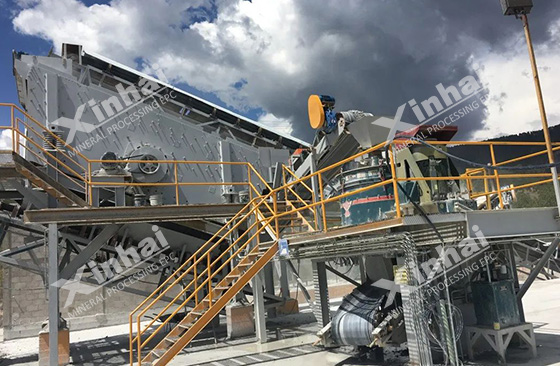
Due to the complex mineral composition of lead-zinc-copper associated silver ore, the symbiotic relationship, embedded properties and oxidation degree of the ores are different, and the effect of silver extraction process is also very different.
At present, flotation is a common method for extracting lead-zinc-copper associated silver ore. According to the process conditions and chemical system of the main metal, it is advisable not to extract the single silver concentrate. The common extraction process is to enrich silver into lead, zinc, and copper concentrates, and then extract silver by smelting. However, in the smelting process, the silver in the lead concentrate enters the crude lead with the main metal, the silver in the copper concentrate enters the matte. Its extraction process is simple, the cost is low, and the recovery rate is high. Whether using pyrometallurgy method or hydrometallurgy process, the silver in the zinc concentrate will all enter the slag. The process of extracting silver by the fuming method is complicated, high in cost and low in recovery rate. Therefore, the silver extraction process should concentrate silver in lead and copper concentrate to the greatest extent.
In general, the recovery rate of lead-zinc-copper associated silver ore is lower than that of silver-gold ore, generally between 50-70%.

In recent years, the rapid increase in demand for silver and the rise in silver prices have led to widespread attention to the comprehensive recovery of lead-zinc-copper polymetallic sulphide ore associated silver ore. In order to obtain the ideal technical and economic indicators for comprehensive recovery of mineral processing, people have strengthened the research of silver extraction process, continuously improved the beneficiation process and the reagent system, so that the ore dressing indicators of lead, zinc, copper and other sulfide ore remain at the original level or improved. The recovery rate of associated silver has been increased from 30%~50% to 60%~80%, and the production of associated silver and the level of comprehensive recovery technology have also been greatly improved.
One of the main measures to improve the associated silver recovery index is to reform the grinding process and improve the grinding fineness.
Various silver minerals are mostly fine-grained in the lead-zinc-copper polymetallic ore, which is closely symbiotic. Most of the existing grinding conditions are considered from the viewpoint of recovering lead, zinc and copper sulfide minerals, and it is difficult to dissociate the silver minerals sufficiently. In order to improve the recovery rate of associated silver, it is necessary to reform the original grinding process and improve the fineness of grinding.
Of course, the selection of grinding process and fineness should not only consider the possibility of technology and scientificity of the process, but also consider the economic rationality.

1. Use cyanide-free or micro-cyanide process
Silver flotation process with no or less use of cyanide, which inhibits silver minerals or carrier minerals, is beneficial to the recovery of associated silver and has received extensive attention. More than 60% of lead-zinc-copper mines have applied this method and achieved good results.
2. Increase collectors’ types and combined use of colletors
In the past, the commonly used collectors for the flotation of lead-zinc polymetallic sulfide ore in China were xanthate (ethyl, butyl) and dithiophosphate (No. 25, No. 31). In recent years, aerofloat has gradually become one of the main collectors for the flotation of lead-zinc polymetallic sulfide ore. It not only has better selectivity, but also shows a strong ability to capture silver minerals. In addition, the combined use of aerofloat with xanthate, ethyl sulfide, esters and other collectors has a good effect on the improvement of mineral processing indicators such as associated silver and lead and zinc. It has been widely used in flotation practice.
3. Improve the silver extraction process
The selection of the mineral processing process should take into account the high-precision indicators of lead metal, lead and zinc, as well as the comprehensive recovery of associated silver, so that the useful minerals are recovered to the maximum extent.
For silver-containing lead-zinc polymetallic sulfide ore, if only the embedding characteristics of the associated silver are considered, the mixed flotation or partial mixing flotation process is adopted, which is beneficial to the comprehensive recovery of the associated silver. However, the selection of the flotation process is determined by various factors, and the nature of the ore is the basis. Therefore, each processing plant should repeat the production practice according to the results of the ore dressing test and gradually improve the existing process.
For silver-based ores, a combined process of gravity-flotation extraction process or a single flotation process is often used to enrich the silver minerals and then the silver concentrates are chemically extracted by chemical methods.
To find out more about our products and solutions, please fill out the form below and one of our experts will get back to you shortly.